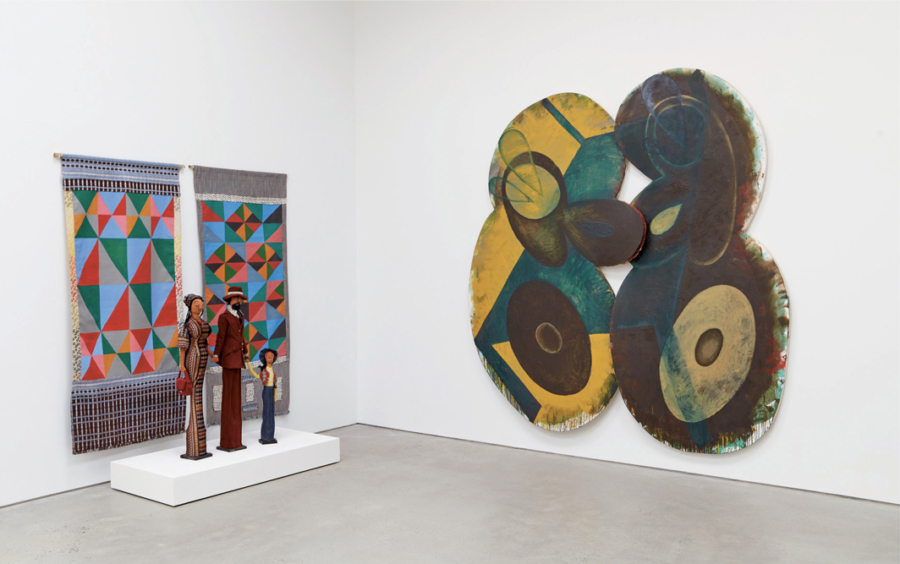January 2023
Download as PDF
View on Artforum

View of “Painting in New York: 1971–83,” 2022. From left: Faith Ringgold, Windows of the Wedding #16: Lovers, 1974; Faith Ringgold, Juanita, Eddie and Caron, 1973; Elizabeth Murray, Table Turning, 1982–83.
From the perspective of many luminaries in the art-critical establishment of yore, the pluralistic 1970s was the decade that went wrong. The messy dismantling of modernism then taking place was tantamount to patricide and shattered the idea of cohesive movements in art. Many lamented the seeming lack of direction, noting the death of painting as another grim marker of decline. Calvin Tomkins went so far as to declare that no major artists emerged in America during those so-called deplorable years. Robert Motherwell proclaimed his fellow Abstract Expressionists the last artists to make substantial contributions to history, while dismissing the next wave as being capable of nothing more than producing the occasional footnote.
Of course, those naysayers were wrong, as yesterday’s multiplicity paved the way for today’s diversity. Women and Black artists stepped out of the shadows and became forces to be reckoned with, while ’80s postmodernism belched up a staggering array of new and hybridized art forms. And, as it turned out, painting never died—it didn’t even take a hiatus.
The challenge now is how to represent the raucous incongruences and discord that characterized the making that went on during that period in Manhattan. In “Painting in New York: 1971–83,” a two-part exhibition that occupied Karma’s 188 and 172 East Second Street locations in Manhattan’s East Village, curator Ivy Shapiro resisted the usual strategies that insist on seamless historical flow and cohesive unity. She selected a group of thirty women artists, highlighting their shared agendas as well as their glaring differences. It’s noteworthy that Shapiro originally considered naming the exhibition “Women Painters in New York: 1971–83,” but then stepped back, as not every artist wanted to be defined by their gender and referred to as a “feminist.” Indeed, many of the figures featured in this show were at odds with one another socially and aesthetically.
Boldly, Shapiro often paired works that were severely discordant, producing symbolic juxtapositions that made the show’s myriad complexities seemingly register all at once. A figurative and folksy soft sculpture by Faith Ringgold, Juanita, Eddie and Caron, 1973, was installed beside an elegantly somber shaped canvas by Elizabeth Murray, Table Turning, 1982–83. The lack of correspondence between Ringgold’s craft aesthetic and Murray’s dialogue with modernist abstraction was shocking, forcing acknowledgment that these stridently different artists belonged to an art world that wasn’t so much heterogeneous as it was racially segregated. In another instance, Sylvia Plimack Mangold’s Untitled, 1972, a small, Apollonian, immaculately executed Photorealist painting of an empty corner of a room, was installed mere inches away from a very large, busy, and steadfastly Dionysian diptych on canvas and Masonite by Nancy Graves: Librium, 1975–76 (its title is also the trade name for an anti-anxiety drug introduced to the market in the 1960s). Graves’s dreamy work is speedy and scattered with whimsical bits of patterning, random marks, pieces of gold leaf, and lots of bright color. In sharp contrast, Mangold’s meditative vision is sustained and cleansed of hyperbole, overt sensuality, and gestural flourish.
It should be noted that Shapiro got her hands on some pretty deep cuts. Ellen Phelan’s Untitled (Water Wheel), ca. 1970s, is a wonderfully strange, freestanding pair of spoked, umbrellalike canvas forms sandwiched together and slathered with viscous black paint. Mary Heilmann’s acrylic-and-collaged-fabric-on-canvas composition Landscape Cupboard (Landscape Closet), 1972, with its playfully regimented series of humps rendered in earthy shades of crimson, teases with its lyrical humor and a sly cartoonish effect that is pure Guston. We saw so many great paintings in this show, which made me realize that we are starved for this art, for its weirdness and adventurous sense of experimentation, its innumerable contradictions. The women whose works comprised this exhibition represent those who took part in a collective struggle, as well as those who refused to join hands and pretend to be sisters. Shapiro’s claim that feminism’s second wave impacted all these artists equally strikes me as a little too simplistic, or totalizing. That queer artists and artists of color experienced and promulgated the same type of feminism as their white, straight, and cisgender counterparts seems rather a stretch, especially in hindsight. Nonetheless, their self-determination is exemplary, and their art is a triumph!



